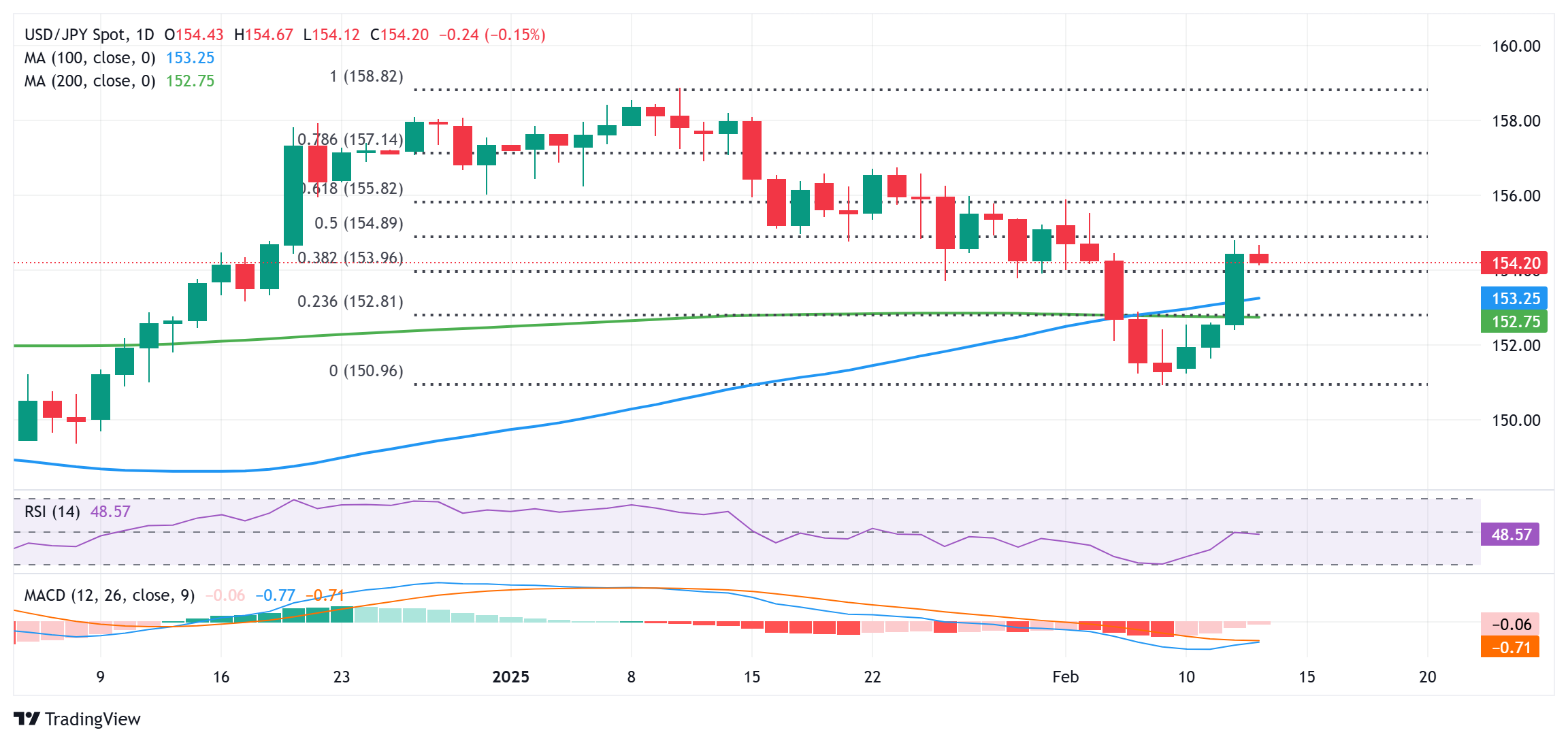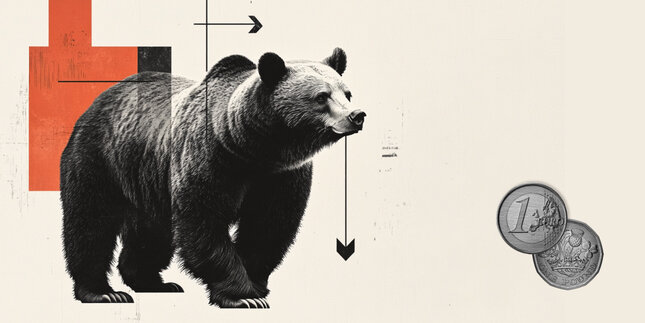Japanese Yen strengthens further against a broadly weaker USD
- The Japanese Yen strengthens on Thursday in reaction to stronger PPI print from Japan.
- Worries about Trump’s trade tariffs might hold back the JPY bulls from placing fresh bets.
- Reduced Fed rate bets could underpin the USD and should help limit losses for USD/JPY.
The Japanese Yen (JPY) builds on steady intraday ascent against its American counterpart, which, along with renewed US Dollar (USD) selling, drags the USD/JPY pair to sub-154.00 levels heading into the European session on Thursday. The stronger Producer Price Index (PPI) released from Japan earlier today reaffirms bets that the Bank of Japan (BoJ) will hike rates further and acts as a tailwind for the JPY. Furthermore, a fresh leg down in the US Treasury bond yields turns out to be another factor benefiting the lower-yielding JPY.
That said, concerns about the implications of US President Donald Trump’s tariffs on steel and aluminum imports, and impending reciprocal tariffs act as a headwind for the JPY. Moreover, expectations that the Federal Reserve (Fed) would stick to its hawkish stance, bolstered by the hot US consumer inflation figures on Wednesday, should help limit deeper losses for the buck and the USD/JPY pair. This, in turn, warrants some caution before positioning for any meaningful USD/JPY decline from over a one-week high touched the previous day.
Japanese Yen builds on intraday move up led by strong PPI print from Japan
- A preliminary report released this Thursday showed that Japan's Producer Price Index (PPI) rose 0.3% MoM in January and by 4.2% compared to the same time period last year.
- This points to signs of broadening inflationary pressures in Japan, which, along with the recent wage growth data, backs the case for additional rate hikes by the Bank of Japan.
- Moreover, BoJ Governor Kazuo Ueda and Deputy Governor Himino recently signaled the possibility of another rate hike if the economy and prices align with the projections.
- The Japanese Yen bulls seem reluctant amid worries that US President Donald Trump's no-exemption tariffs on commodity imports could endanger Japan's economic stability.
- The US Bureau of Labor Statistics reported on Wednesday that the headline US Consumer Price Index rose 0.5% in January – the most since August 2023 and higher than estimated.
- The yearly rate climbed to 3% from 2.9% in December, while the core CPI (which excludes food and energy prices) jumped 3.3% from a year ago compared to 3.1% expected.
- The data underscores still sticky inflation, which, along with Friday's mostly upbeat US employment details, suggests that the Federal Reserve will stick to its hawkish stance.
- Fed Chair Jerome Powell said that the central bank wants to keep monetary policy restrictive for now as inflation, though easing, remains elevated above the 2% target.
- The yield on the benchmark 10-year US government bond registered its biggest one-day rise since December on hot US CPI print, widening the US-Japan rate differential.
- Investors now look forward to the US PPI print, which, along with the US Weekly Initial Jobless Claims, might influence the US Dollar and drive the USD/JPY pair.
USD/JPY could weaken further once the 153.75-153.70 support is broken
From a technical perspective, the overnight breakout through the 152.75 confluence hurdle and the subsequent move beyond the 38.2% Fibonacci retracement level of the January-February decline favor bullish traders. That said, oscillators on the daily chart – though they have recovered from negative territory – are yet to confirm a positive outlook. This makes it prudent to wait for some follow-through buying beyond the 154.75-154.80 region, or the 50% retracement level, before positioning for further gains. The USD/JPY pair might then surpass the 155.00 psychological mark, towards the next relevant hurdle near the 155.45-155.50 region and the 156.00 neighborhood, or the 61.8% Fibo. level.
On the flip side, the 154.00 mark, closely followed by the 153.75-153.70 area, now seems to protect the immediate downside. Some follow-through selling could drag the USD/JPY pair towards the 153.00 round figure, representing the 100-day Simple Moving Average (SMA), en route to the 152.75 confluence. The latter comprises the 200-day SMA and the 23.6% Fibo. level, which, in turn, should now act as a key pivotal point. A convincing break below would expose sub-151.00 levels, or a near two-month low touched last Friday, with some intermediate support near the 151.40 area.
US Dollar PRICE Today
The table below shows the percentage change of US Dollar (USD) against listed major currencies today. US Dollar was the strongest against the Australian Dollar.
| USD | EUR | GBP | JPY | CAD | AUD | NZD | CHF | |
|---|---|---|---|---|---|---|---|---|
| USD | -0.40% | -0.38% | -0.25% | -0.18% | -0.10% | -0.15% | -0.19% | |
| EUR | 0.40% | 0.01% | 0.16% | 0.22% | 0.27% | 0.24% | 0.21% | |
| GBP | 0.38% | -0.01% | 0.13% | 0.20% | 0.28% | 0.23% | 0.20% | |
| JPY | 0.25% | -0.16% | -0.13% | 0.06% | 0.14% | 0.05% | 0.06% | |
| CAD | 0.18% | -0.22% | -0.20% | -0.06% | 0.08% | 0.02% | -0.01% | |
| AUD | 0.10% | -0.27% | -0.28% | -0.14% | -0.08% | -0.05% | -0.08% | |
| NZD | 0.15% | -0.24% | -0.23% | -0.05% | -0.02% | 0.05% | -0.04% | |
| CHF | 0.19% | -0.21% | -0.20% | -0.06% | 0.00% | 0.08% | 0.04% |
The heat map shows percentage changes of major currencies against each other. The base currency is picked from the left column, while the quote currency is picked from the top row. For example, if you pick the US Dollar from the left column and move along the horizontal line to the Japanese Yen, the percentage change displayed in the box will represent USD (base)/JPY (quote).
Tariffs FAQs
Tariffs are customs duties levied on certain merchandise imports or a category of products. Tariffs are designed to help local producers and manufacturers be more competitive in the market by providing a price advantage over similar goods that can be imported. Tariffs are widely used as tools of protectionism, along with trade barriers and import quotas.
Although tariffs and taxes both generate government revenue to fund public goods and services, they have several distinctions. Tariffs are prepaid at the port of entry, while taxes are paid at the time of purchase. Taxes are imposed on individual taxpayers and businesses, while tariffs are paid by importers.
There are two schools of thought among economists regarding the usage of tariffs. While some argue that tariffs are necessary to protect domestic industries and address trade imbalances, others see them as a harmful tool that could potentially drive prices higher over the long term and lead to a damaging trade war by encouraging tit-for-tat tariffs.
During the run-up to the presidential election in November 2024, Donald Trump made it clear that he intends to use tariffs to support the US economy and American producers. In 2024, Mexico, China and Canada accounted for 42% of total US imports. In this period, Mexico stood out as the top exporter with $466.6 billion, according to the US Census Bureau. Hence, Trump wants to focus on these three nations when imposing tariffs. He also plans to use the revenue generated through tariffs to lower personal income taxes.
Forex News
Keep up with the financial markets, know what's happening and what is affecting the markets with our latest market updates. Analyze market movers, trends and build your trading strategies accordingly.










